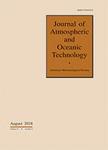版权所有:内蒙古大学图书馆 技术提供:维普资讯• 智图
内蒙古自治区呼和浩特市赛罕区大学西街235号 邮编: 010021

作者机构:Univ Extremadura Dept Phys E-06071 Badajoz Spain
出 版 物:《JOURNAL OF ATMOSPHERIC AND OCEANIC TECHNOLOGY》 (大气与海洋技术杂志)
年 卷 期:2015年第32卷第11期
页 面:2088-2099页
核心收录:
学科分类:07[理学] 070601[理学-气象学] 0706[理学-大气科学] 0824[工学-船舶与海洋工程]
基 金:Ministerio de Economia y Competitividad from Spain [CGL2011-29921-C02-01, CGL2014-56255-C2-1-R] Ministerio de Ciencia e Innovacion
主 题:Physical Meteorology and Climatology Irradiance Shortwave radiation Observational techniques and algorithms Instrumentation sensors
摘 要:A main source of error in solar radiation measurements is the thermal offset inherent to pyranometers. Despite acknowledgment of its importance, its correction has been widely ignored for several decades. This neglect may have caused a generalized underestimation in solar radiation measurements. This study focuses on the correction of this error in solar irradiance measurements. For this aim a plethora of correction models built as a linear combination of several environmental variables related to the ambient temperature and to the incoming radiation were proposed. The models are fitted to experimental measurements obtained during capping events and, finally, their performance is evaluated and compared. The main results indicate that models with only one independent variable moderately correct the thermal offset error. These simple models are useful when no additional instrumentation other than the pyranometer is available. On the other hand, the more complex models show the best performance, with a coefficient of determination R-2 over 0.8, an RMSE under 2 W m(-2), and an absolute value of mean bias error (MBE) under 0.5 W m(-2). Additionally, these models are used to study the differences between nighttime and daytime correction, revealing the unsuitability of using nighttime-fitted models to correct the daytime thermal offset. The general validity of the models is tested by their application to two different pyranometers. Results indicate that, whereas the factors involved in the best-performing models are the same, the values of the loading coefficients differ and therefore must be specifically calculated for each pyranometer.